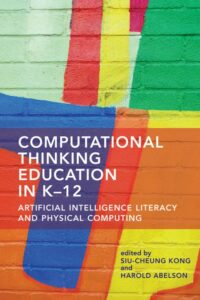Computational Thinking Education in K-12

|
Nieuw boek
Kong, S.-C. and Abelson, H. (Eds.). (2022). Computational thinking education in K-12. Artificial Intelligence Literacy and Physical Computing. |
A guide to computational thinking education, with a focus on artificial intelligence literacy and the integration of computing and physical objects. Computing has become an essential part of today’s primary and secondary school curricula. In recent years, K–12 computer education has shifted from computer science itself to the broader perspective of computational thinking (CT), which is less about technology than a way of thinking and solving problems—“a fundamental skill for everyone, not just computer scientists,” in the words of Jeanette Wing, author of a foundational article on CT. This volume introduces a variety of approaches to CT in K–12 education, offering a wide range of international perspectives that focus on artificial intelligence (AI) literacy and the integration of computing and physical objects.
Part I – A Multiplicity of Computational Thinkings
- A Case for Why: Society, School, Self, Karen Brennan. https://doi.org/10.7551/mitpress/13375.003.0004
- Providing Students with Computational Literacy for Learning About Everything, Mark Guzdial. https://doi.org/10.7551/mitpress/13375.003.0005
- Developing Computational Thinking Skills with Multiple Models and Representations, H. Ulrich Hoppe, Sven Manske. https://doi.org/10.7551/mitpress/13375.003.0006
- Toward a Theory (and Practice) of Multiple Computational Thinkings, Marcos Román-González, Jesús Moreno-León, Gregorio Robles. https://doi.org/10.7551/mitpress/13375.003.0007
- Learning Computational Thinking in Phenomena-Based Co-creation Projects: Perspectives from Finland, Pasi Silander, Sini Riikonen, Pirita Seitamaa-Hakkarainen, Kai Hakkarainen. https://doi.org/10.7551/mitpress/13375.003.0008
- Computational Empowerment, Christian Dindler, Ole Sejer Iversen, Michael E. Caspersen, Rachel Charlotte Smith. https://doi.org/10.7551/mitpress/13375.003.0009
Part II: Computational Thinking and Artificial Intelligence Literacy in K–12
- The Computational Thinking and Artificial Intelligence Duality, Fredrik Heintz. https://doi.org/10.7551/mitpress/13375.003.0012
- Artificial Intelligence Thinking in K–12. David S. Touretzky, Christina Gardner-McCune. https://doi.org/10.7551/mitpress/13375.003.0013
- Preparing Children to Be Conscientious Consumers and Designers of AI Technologies. Daniella DiPaola, Blakeley H. Payne, Cynthia Breazeal. https://doi.org/10.7551/mitpress/13375.003.0014
III: Computational Thinking And Physical Computing Education In K–12
- Examining the Multidimensional Learning Affordances of Robotics for Computational Thinking and Science Inquiry, Florence R. Sullivan. https://doi.org/10.7551/mitpress/13375.003.0017
- Toward a Research Agenda for Developing Computational Thinking Skills by Sense-Reason-Act Programming with Robots
By Nardie Fanchamps, Marcus Specht, Lou Slangen, Paul Hennissen. https://doi.org/10.7551/mitpress/13375.003.0018 - Computational Thinking in the Interdisciplinary Robotic Game: the Charm of STEAM. Ju-Ling Shih. https://doi.org/10.7551/mitpress/13375.003.0019


